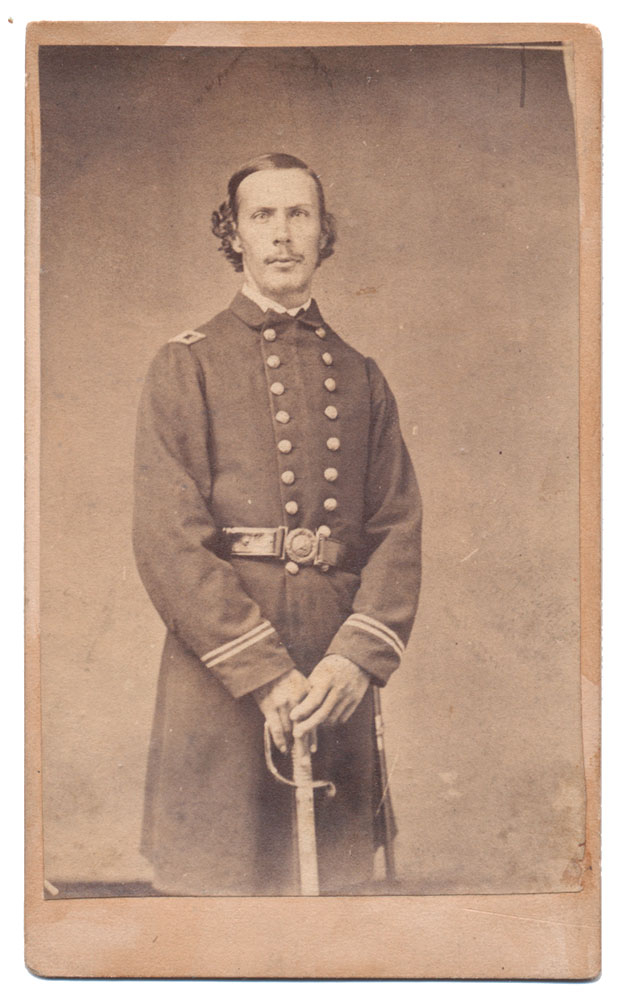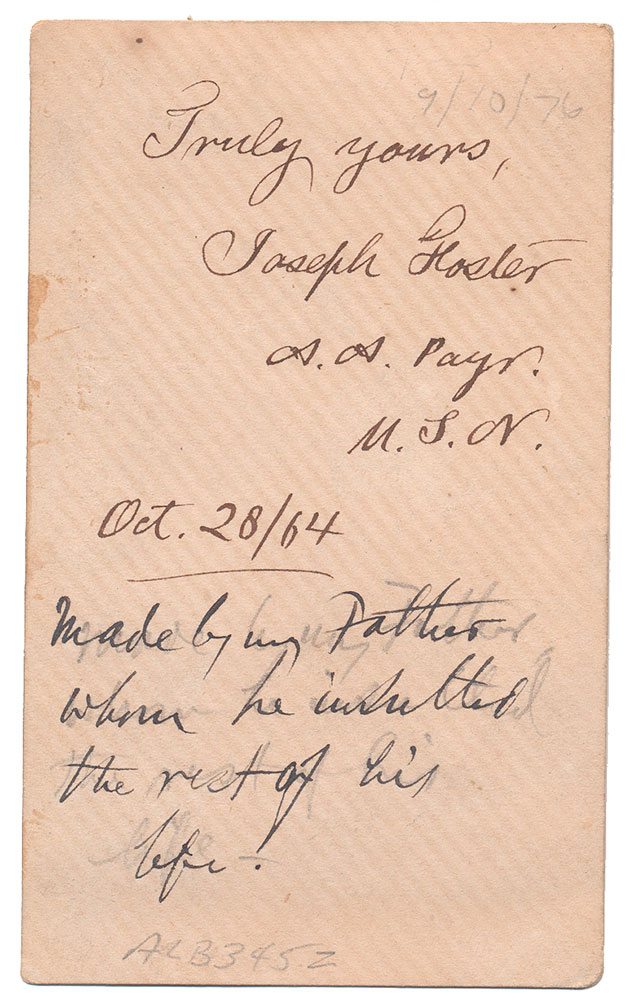site search
online catalog
INK SIGNED THREE-QUARTER STANDING VIEW OF US NAVY PAYMASTER JOSEPH FOSTER

Hover to zoom


$125.00
Quantity Available: 1
Item Code: 160-481
Shipping: Determined by Method & Location of buyer
To Order:
Call 717-334-0347,
Fax 717-334-5016, or E-mail
Foster is posed with his hands resting on the hilt of his sword which is drawn and placed in front of him. He wears a dark double-breasted frock coat with shoulder straps with two stripes on each cuff.
Contrast and clarity are very good. Mount and paper have the usual light surface dirt.
Reverse does not have a photographer’s imprint but there is a nice period ink inscription of “TRULY YOURS, JOSEPH FOSTER, A.A. PAYR. U. S. N. OCT. 28/64.” Below this is another inscription done in period pencil but gone over in black ink. It reads “MADE BY MY FATHER WHEN HE ???? THE REST OF HIS LIFE.”
Joseph Foster was born on June 17, 1841 in Gloucester, Massachusetts. He is listed as living in Portsmouth, New Hampshire when he was made acting assistant paymaster on October 19, 1863. At the time he was 22 years old. He was made assistant paymaster on July 23, 1866 and paymaster on February 23, 1877. His date of discharge is not known. He served for a time aboard the steamer USS ACACIA.
After the war, he lived in Washington, D.C. and died in Portsmouth on May 17, 1930. His headstone says that he rose to the rank of Rear Admiral.
USS ACACIA was a steam-powered tugboat in the service of the United States Navy during the Civil War, named after the Acacia tree.
She was launched at Vicksburg sometime in September 1863, purchased and renamed by the Navy at Boston, Massachusetts on 28 October 1863, and commissioned in the Boston Navy Yard on 8 December 1863 with Acting Master John D. Childs in command.
While the new tug was preparing for service in the South Atlantic Blockading Squadron, 17 Confederate agents disguised as passengers seized the CHESAPEAKE off Cape Cod, Massachusetts on 7 December 1863 as that packet was steaming from New York City to Portland, Maine. The liner's captors took her to Saint John, New Brunswick, where, the next day, they landed the prize's bona-fide passengers, her former captain, and most of her crew.
Word of the takeover reached Portland on the morning of 9 December and quickly spread from there. The news prompted Federal officials at northern ports along the coast to speedy action.
At 16:00 that afternoon, USS ACACIA sailed in search of the CHESAPEAKE. En route, however, she began taking on water so fast that she soon found herself "in a sinking condition" and was forced to seek haven at Portland. On the morning of 11 December, Childs wired from there back to Boston, "Through the help of the fire department the ACACIA is now alongside a wharf, where she cannot sink."
Her work along the Canadian coast completed, ACACIA returned to Boston and resumed her preparation for blockade duty along the coast of the Carolinas. When ready, she proceeded south via Hampton Roads, Virginia, and arrived off Morris Island, South Carolina on the evening of 6 January 1864. The tug served in the South Atlantic Blockading Squadron for the remainder of the war, spending most of her time near Breach Inlet in the line of Union warships outside Charleston Bar. From time to time during her deployment, she had brushes with blockade runners, occasionally forcing the escaping ships to turn back into port and compelling vessels attempting to enter back out to sea.
Ironically, her greatest success came on the morning of 23 December, not when she was on her blockade station, but while she was steaming from Charleston bar to Georgetown, South Carolina, with provisions for screw sloop CANANDAIGUA. As she was passing Cape Romain Shoal, a lookout in the masthead reported two white smokestacks close inshore. ACACIA altered course and, "on closing in toward the bar, discovered ... a sidewheel steamer of perhaps 400 long tons. No colors could be seen." The stranger's decks were crowded with men preparing to abandon her.
ACACIA continued "in as near as the depth of water would admit and fired a shell over her." She then lowered her boats, armed them for boarding, and fired another shot over them as they approached the stranded ship. The stranded steamer then sent up white flags as her own boats began pulling toward the mouth of Alligator Creek where they escaped.
Not a soul remained on board the blockade runner when the Union sailors reached her shortly past noon. Upon boarding the prize, they learned that she was JULIA, a fast, shallow-draft, iron-hulled vessel built in 1863 at Renfrew, Scotland — apparently for the express purpose of violating the Federal blockade. "Her engines had been purposely disabled ..." and she was hard aground. The almost heroic efforts of the boarding party managed to get JULIA afloat and underway on her own power shortly after daylight on the following morning, and she was ultimately sent to Key West where she was condemned by the prize court.
After the end of the Civil War, ACACIA sailed for Philadelphia on 24 April 1865. She was decommissioned in the navy yard at that port on 12 May and sold at public auction there. Redocumented as SS WABASH on 13 October, she served as a merchantman until abandoned in 1881. [ad][ph:L]
~~~~~~~~~~~~~~~~~~~~~~~~~~~~~~~~~~~
THIS ITEM, AS WITH ALL OTHER ITEMS AVAILABLE ON OUR WEB SITE,
MAY BE PURCHASED THROUGH OUR LAYAWAY PROGRAM.
CLICK HERE FOR OUR POLICIES AND TERMS.
THANK YOU!
Inquire About INK SIGNED THREE-QUARTER STANDING VIEW OF US NAVY PAYMASTER JOSEPH FOSTER
Most Popular
Historical Firearms Stolen From The National Civil War Museum In Harrisburg, Pa »
Theft From Gravesite Of Gen. John Reynolds »
Selection Of Unframed Prints By Don Troiani »
Fine Condition Brass Infantry Bugle Insignia »
Large English Bowie Knife With Sheath 1870’S – 1880’S »
Imported (Clauberg) Us Model 1860 Light Cavalry Officer's Saber »
featured item
CIVIL WAR US NAVY LT. COMMANDER’S COAT AND BUCKLE OF ALEXANDER COLE RHIND - USS CONSTELLATION, USS CRUSADER, USS KEOKUK, FOUGHT CS BATTERIES AT DEEP BOTTOM, COMMANDED A “POWDER BOAT” AGAINST FT. FISHER, LATER REAR ADMIRAL
This is a very appealing regulation Civil War navy officer’s frock coat with interesting history. The coat is very dark blue, almost black, double-breasted with two rows of 9 US Navy officer’s button each down the front, two at the rear waist,… (1179-650). Learn More »


